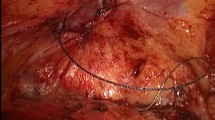Abstract
Introduction
Seroma is a frequent complication of endoscopic totally extraperitoneal (TEP) mesh repair of direct inguinal hernia that may cause discomfort and anxiety. Its volume is proportional to the size of the preperitoneal dead space created after the reduction of the hernia. Attempts to reduce its incidence have included tacking the transversalis fascia (TF) to the pubic ramus or closed suction drainage of the preperitoneal space. Both of these techniques are not without problems. The aim of this study was to evaluate the efficiency of a new alternate technique that must be safe and easily reproducible, using a widely available and inexpensive pre-tied suture loop (Endoloop® Ligature) for plication of the weakened TF.
Methods
This is a prospective study of consecutive patients diagnosed with inguinal hernia during a 33-month period and eligible for endoscopic TEP repair. A single surgeon performed all operations. Each of the M2 or M3 direct defects, according to the European Hernia Society (EHS), were systematically closed prior to the introduction of the prosthetic mesh and as follows: grasping and inversion of the attenuated TF at its apex, using a laparoscopic forceps and plication of the TF by placing a tight Endoloop of Polydioxanone (PDS) at its base. All meshes were secured with fibrin sealant only. Patients were reviewed in the clinic 2 and 6 weeks after the operation. Further follow-up was scheduled if it was deemed necessary. The primary post-operative outcome parameter was seroma formation; secondary outcome parameters included groin pain, surgical complications, and recurrence.
Results
Two hundred and fifty hernia repairs were prospectively recorded during this period. All procedures were carried out endoscopically. Seventy-nine patients with 94 direct inguinal hernias were selected in a sequential manner. There were 75 males and four females, with a median age of 57 years. Of those, 55 were combined with an indirect inguinal defect. In total, Endoloops of PDS were used to close the weakened TF in 76 cases (30 M3, 44 M2, and two M1). Only one patient (1.3%) complained of a residual seroma formation, which was still clinically present at 3 months post-operatively, but was not symptomatic. There were only two minor post-operative complications, which occurred in the same patient and were not related to the Endoloop technique. Finally, no patient complained of chronic groin pain and there was no hernia recurrence after a median follow-up of 18 months.
Conclusions
The primary closure of direct inguinal hernia defects with a pre-tied suture loop during endoscopic TEP repair is safe, efficient, and very reliable for the prevention of post-operative seroma formation, without increasing the risk of developing chronic groin pain or hernia recurrence. This technique should be the preferred method over stapling of the TF or the insertion of a closed suction drainage device in such a situation.


Similar content being viewed by others
References
Lau H, Lee F (2003) Seroma following endoscopic extraperitoneal inguinal hernioplasty. Surg Endosc 17:1773–1777
Simons MP, Aufenacker T, Bay-Nielsen M, Bouillot JL, Campanelli G, Conze J, de Lange D, Fortelny R, Heikkinen T, Kingsnorth A, Kukleta J, Morales-Conde S, Nordin P, Schumpelick V, Smedberg S, Smietanski M, Weber G, Miserez M (2009) European Hernia Society guidelines on the treatment of inguinal hernia in adult patients. Hernia 13:343–403
Ismail M, Garg M, Rajagopal M, Garg P (2009) Impact of closed-suction drain in preperitoneal space on the incidence of seroma formation after laparoscopic total extraperitoneal inguinal hernia repair. Surg Laparosc Endosc Percutan Tech 19:263–266
Reddy VM, Sutton CD, Bloxham L, Garcea G, Ubhi SS, Robertson GS (2007) Laparoscopic repair of direct inguinal hernia: a new technique that reduces the development of postoperative seroma. Hernia 11:393–396
Miserez M, Alexandre JH, Campanelli G, Corcione F, Cuccurullo D, Pascual MH, Hoeferlin A, Kingsnorth AN, Mandala V, Palot JP, Schumpelick V, Simmermacher RK, Stoppa R, Flament JB (2007) The European Hernia Society groin hernia classification: simple and easy to remember. Hernia 11:113–116
Links DJ, Berney CR (2010) Initial experience with endoloop technique to reduce post-operative seroma after totally extraperitoneal (TEP) repair of direct inguinal hernias (DIH). ANZ J Surg 80(Suppl 1):A30–A38
Khaleal F, Berney CR (2011) The role of fibrin glue in decreasing chronic pain in laparoscopic totally extraperitoneal (TEP) inguinal hernia repair: a single surgeon’s experience. ANZ J Surg 81:154–158
Schwab R, Willms A, Kröger A, Becker HP (2006) Less chronic pain following mesh fixation using a fibrin sealant in TEP inguinal hernia repair. Hernia 10:272–277
Topart P, Vandenbroucke F, Lozac’h P (2005) Tisseel versus tack staples as mesh fixation in totally extraperitoneal laparoscopic repair of groin hernias: a retrospective analysis. Surg Endosc 19:724–727
Lau H (2005) Fibrin sealant versus mechanical stapling for mesh fixation during endoscopic extraperitoneal inguinal hernioplasty: a randomized prospective trial. Ann Surg 242:670–675
Amid PK (2004) Radiologic images of meshoma: a new phenomenon causing chronic pain after prosthetic repair of abdominal wall hernias. Arch Surg 139:1297–1298
Teng YJ, Pan SM, Liu YL, Yang KH, Zhang YC, Tian JH, Han JX (2011) A meta-analysis of randomized controlled trials of fixation versus nonfixation of mesh in laparoscopic total extraperitoneal inguinal hernia repair. Surg Endosc 25:2849–2858
Lowham AS, Filipi CJ, Fitzgibbons RJ Jr, Stoppa R, Wantz GE, Felix EL, Crafton WB (1997) Mechanisms of hernia recurrence after preperitoneal mesh repair. Traditional and laparoscopic. Ann Surg 225:422–431
Author information
Authors and Affiliations
Corresponding author
Rights and permissions
About this article
Cite this article
Berney, C.R. The Endoloop technique for the primary closure of direct inguinal hernia defect during the endoscopic totally extraperitoneal approach. Hernia 16, 301–305 (2012). https://doi.org/10.1007/s10029-011-0892-z
Received:
Accepted:
Published:
Issue Date:
DOI: https://doi.org/10.1007/s10029-011-0892-z




